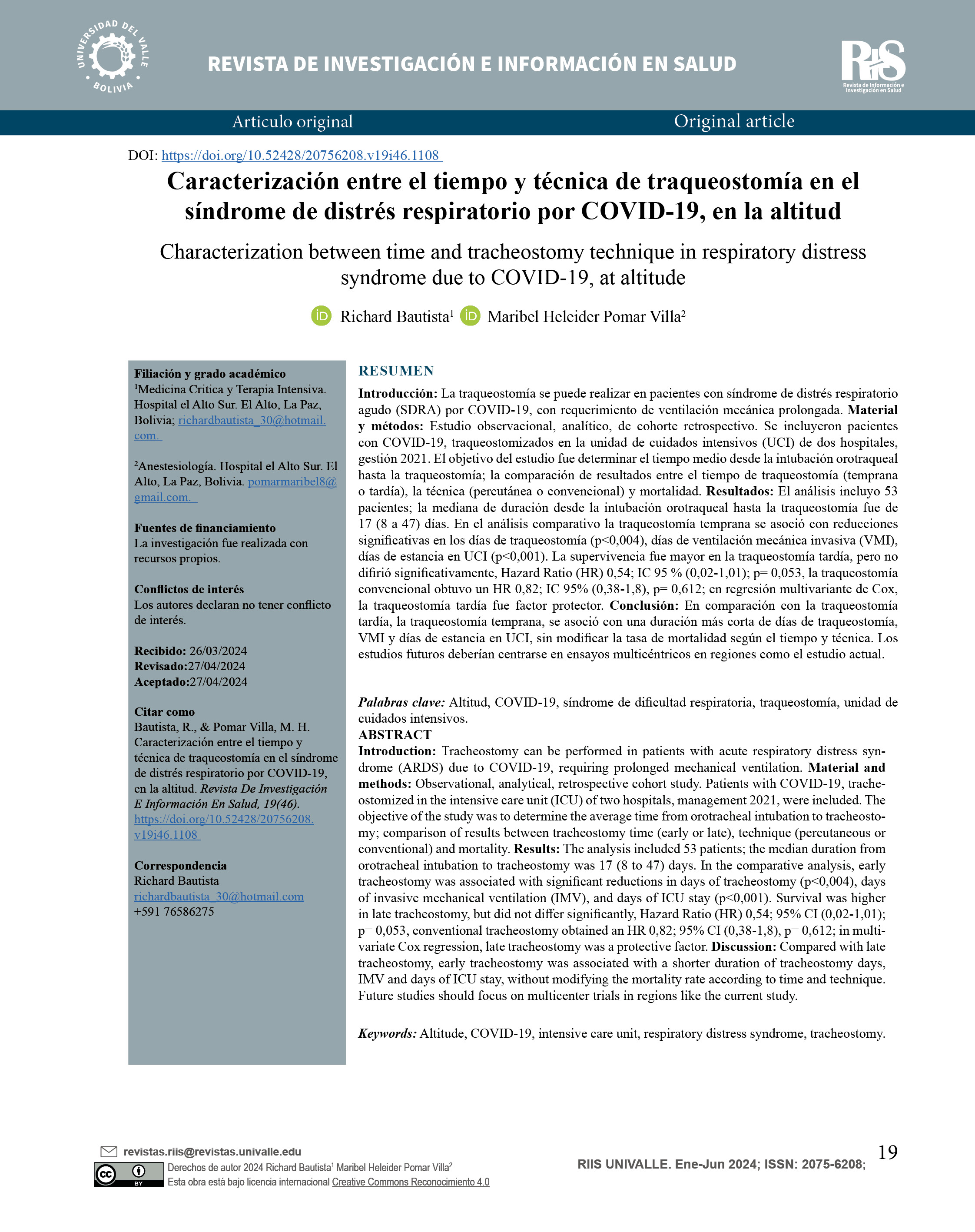Characterization between time and technique of tracheostomy in respiratory distress syndrome due to COVID-19, at altitude
DOI:
https://doi.org/10.52428/20756208.v19i46.1108Keywords:
Traqueostomía, tiempo y técnica, COVID-19, SDRAAbstract
Introduction: Tracheostomy is performed in patients with Acute Respiratory Distress Syndrome (ARDS) due to COVID-19, in which they are expected to require prolonged mechanical ventilation. Design: Observational, analytical retrospective cohort study. Methods: Patients with COVID-19, tracheostomized in the intensive care unit (ICU) of two hospitals, management 2021, were included. The objective of the study was to determine the average time from orotracheal intubation to tracheostomy, the comparison of results between the tracheostomy time (early or late), technique (percutaneous or conventional) and mortality. Results: The analysis included 53 patients. The median duration from orotracheal intubation to tracheostomy was 17 (8-47) days. In the comparative analysis, early tracheostomy was associated with significant reductions in days of tracheostomy (p<0.004), days of mechanical ventilation, and days of ICU stay (p<0.001). Survival was higher in late tracheostomy, but did not differ significantly, Hazard Ratio (HR) 0.54; 95% CI, 0.02-1.01; p-value: 0.053, conventional tracheostomy obtained an HR 0.82 (95% CI: 0.38 - 1.8) p-value: 0.612, in multivariate Cox regression, late tracheostomy was a protective factor. Conclusion: Compared with late tracheostomy, early tracheostomy was associated with a shorter duration of tracheostomy days, IMV and days of ICU stay, without modifying the mortality rate according to time and technique. Future studies should focus on multicenter trials in regions like the current study.
Keywords: Tracheostomy, time and technique, COVID-19, ARDS.
Downloads
References
Farlow JL, Park PK, Sjoding MW, Kay SG, Blank R, Malloy KM, et al. Tracheostomy for COVID-19 respiratory failure: timing, ventilatory characteristics, and outcomes. J Thorac Dis 2021;13(7):4137-4145. doi: 10.21037/jtd-21-10.
https://doi.org/10.21037/jtd-21-10 DOI: https://doi.org/10.21037/jtd-21-10
PMid:34422343 PMCid:PMC8339767
Courtney A, Lignos L, Ward PA, Vizcaychipi MP. Surgical tracheostomy outcomes in COVID-19-positive patients. OTO Open. 2021; 5(1):2473974x20984998.
https://doi.org/10.1177/2473974X20984998 DOI: https://doi.org/10.1177/2473974X20984998
PMid:33474524 PMCid:PMC7797581
Nseir S, Di Pompeo C, Jozefowicz E, et al. Relationship between tracheotomy and ventilator-associated pneumonia: a case control study. Eur Respir J. 2007; 30(2): 314-320.
https://doi.org/10.1183/09031936.06.00024906 DOI: https://doi.org/10.1183/09031936.06.00024906
PMid:16870667
Mattioli F, Fermi M, Ghirelli M, et al. Tracheostomy in the COVID-19 pandemic. Eur Arch Otorhinolaryngol. 2020; 277(7): 2133-2135.
https://doi.org/10.1007/s00405-020-05982-0 DOI: https://doi.org/10.1007/s00405-020-05982-0
PMid:32322959 PMCid:PMC7174541
Terragni, P.P.; Antonelli, M.; Fumagalli, R.; Faggiano, C.; Berardino, M.; Pallavicini, F.B.; Miletto, A.; Mangione, S.; Sinardi, A.U.;
Pastorelli, M.; et al. Early vs. Late Tracheotomy for Prevention of Pneumonia in Mechanically Ventilated Adult ICU Patients.JAMA 2010; 303, 1483.
https://doi.org/10.1001/jama.2010.447 DOI: https://doi.org/10.1001/jama.2010.447
PMid:20407057
Blot, F.; Similowski, T.; Trouillet, J.-L.; Chardon, P.; Korach, J.-M.; Costa, M.-A.; Journois, D.; Thiéry, G.; Fartoukh, M.; Pipien, I.;et al. Early tracheotomy versus prolonged endotracheal intubation in unselected severely ill ICU patients. Intensive Care Med.2008, 34, 1779-1787.
https://doi.org/10.1007/s00134-008-1195-4 DOI: https://doi.org/10.1007/s00134-008-1195-4
PMid:18592210
Freeman, B.D. Tracheostomy Update. Crit. Care Clin. 2017, 33, 311-322.
https://doi.org/10.1016/j.ccc.2016.12.007 DOI: https://doi.org/10.1016/j.ccc.2016.12.007
PMid:28284297
Silvester W., Goldsmith D., Uchino S., Bellomo R., Knight S., Seevanayagam S., Brazzale D., et al. Percutaneous versus surgical tracheostomy: A randomized controlled study with long-term follow-up*. Crit. Care Med. 2006;34:2145-2152. doi: 10.1097/01.CCM.0000229882.09677.FD.
https://doi.org/10.1097/01.CCM.0000229882.09677.FD DOI: https://doi.org/10.1097/01.CCM.0000229882.09677.FD
PMid:16775568
Bellani, G.; Laffey, J.G.; Pham, T.; Fan, E.; Brochard, L.; Esteban, A.; Gattinoni, L.; van Haren, F.; Larsson, A.; McAuley, D.F.; et al. Epidemiology, Patterns of Care, and Mortality for Patients with Acute Respiratory Distress Syndrome in Intensive Care Units in 50 Countries. JAMA 2016, 315, 788.
https://doi.org/10.1001/jama.2016.0291 DOI: https://doi.org/10.1001/jama.2016.0291
PMid:26903337
Breik, O.; Nankivell, P.; Sharma, N.; Bangash, M.N.; Dawson, C.; Idle, M.; Isherwood, P.; Jennings, C.; Keene, D.; Manji, M.; et al. Safety and 30-day outcomes of tracheostomy for COVID-19: A prospective observational cohort study. Br. J. Anaesth. 2020, 125, 872-879. [Google Scholar] [CrossRef] [PubMed]
https://doi.org/10.1016/j.bja.2020.08.023 DOI: https://doi.org/10.1016/j.bja.2020.08.023
PMid:32988602 PMCid:PMC7455111
Angel, L.; Kon, Z.N.; Chang, S.H.; Rafeq, S.; Palasamudram Shekar, S.; Mitzman, B.; Amoroso, N.; Goldenberg, R.; Sureau, K.; Smith, D.E.; et al. Novel Percutaneous Tracheostomy for Critically Ill Patients With COVID-19. Ann. Thorac. Surg. 2020, 110, 1006-1011.
https://doi.org/10.1016/j.athoracsur.2020.04.010 DOI: https://doi.org/10.1016/j.athoracsur.2020.04.010
PMid:32339508 PMCid:PMC7182508
Iftikhar, I.H.; Teng, S.; Schimmel, M.; Duran, C.; Sardi, A.; Islam, S. A Network Comparative Meta-analysis of Percutaneous Dilatational Tracheostomies Using Anatomic Landmarks, Bronchoscopic, and Ultrasound Guidance Versus Open Surgical Tracheostomy. Lung 2019, 197, 267-275.
https://doi.org/10.1007/s00408-019-00230-7 DOI: https://doi.org/10.1007/s00408-019-00230-7
PMid:31020401
Picetti E, Fornaciari A, Taccone FS, Malchiodi L, Grossi S, et al.Safety of bedside surgical tracheostomy during COVID-19 pandemic: A retrospective observational study. PLOS ONE.2020; 15(9): e0240014.
https://doi.org/10.1371/journal.pone.0240014 DOI: https://doi.org/10.1371/journal.pone.0240014
PMid:32997704 PMCid:PMC7526872
Ji, Y., Fang, Y., Cheng, B. et al. Tracheostomy timing and clinical outcomes in ventilated COVID-19 patients: a systematic review and meta-analysis. Crit Care 2022; 26, 40.
https://doi.org/10.1186/s13054-022-03904-6 DOI: https://doi.org/10.1186/s13054-022-03904-6
PMid:35135597 PMCid:PMC8822732
Kamel Abd Elaziz Mohamed, Ahmed Yehia Mousa, Ahmed Samir ElSawy, Adel Mohamed Saleem.Early versus late percutaneous tracheostomy in critically ill adult mechanically ventilated patients.Egyptian Journal of Chest Diseases and Tuberculosis.2014;63 (2) 443-448.
https://doi.org/10.1016/j.ejcdt.2014.01.008 DOI: https://doi.org/10.1016/j.ejcdt.2014.01.008

Published
How to Cite
Issue
Section
License
Copyright (c) 2024 Richard Bautista, Maribel Heleider Pomar Villa

This work is licensed under a Creative Commons Attribution 4.0 International License.
Authors who publish with this journal agree to the following terms:
- Authors retain copyright and grant the journal right of first publication with the work simultaneously licensed under a Creative Commons Attribution License 4.0 that allows others to share the work with an acknowledgement of the work's authorship and initial publication in this journal.
- Authors are able to enter into separate, additional contractual arrangements for the non-exclusive distribution of the journal's published version of the work (e.g., post it to an institutional repository or publish it in a book), with an acknowledgement of its initial publication in this journal.
- Authors are permitted and encouraged to post their work online (e.g., in institutional repositories or on their website) prior to and during the submission process, as it can lead to productive exchanges, as well as earlier and greater citation of published work.






















